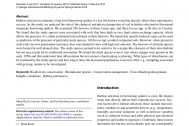Rok
2018Autoři
RNDr. Milan Řezáč, Ph.D.Druhy
Atypus affinis Eichwald, 1830 LCAtypus muralis Bertkau, 1890 EN
Atypus piceus (Sulzer, 1776) VU
Eresus hermani Kovács, Prazsák, Eichardt, Vári & Gyurkovics, 2015 CR
Eresus kollari Rossi, 1846 VU
Eresus moravicus Řezáč, 2008 CR
Eresus sandaliatus (Martini & Goeze, 1778) CR
Obsah
Habitat selection in sedentary, long-lived burrowing spiders is a key life-history event that directly affects their reproductive success. In this study, we analyzed the role of the chemical and physical properties of soil in habitat selection by threatened temperate burrowing spiders. We examined 296 burrows of three Atypus spp. and three Eresus spp. at 68 sites in Czechia. We found that the study species were associated with soils that have high or very high cation exchange capacity, which allows the presence of a stable nd humid microclimate in their burrows. We found that specific bedrock types can be used as predictors of the presence of particular study species. All Eresus spp. avoided compacted soils. However, when present in soils with very low penetration resistance, they were limited to sites with high soil cohesion. The burrows of all study species were located at well-drained sites. The study species seemed to be selective for a steppe-like character of their microhabitat but not necessarily for its southward orientation. We found the study species even at sites where steppes were present in the early 1950s and that underwent later afforestation but not extensive landscaping or plowing. What types of disturbances can be sustained by the study species and how long it takes the decreased populations to recover after, e.g., trampling associated with grazing, remain to be investigated.



